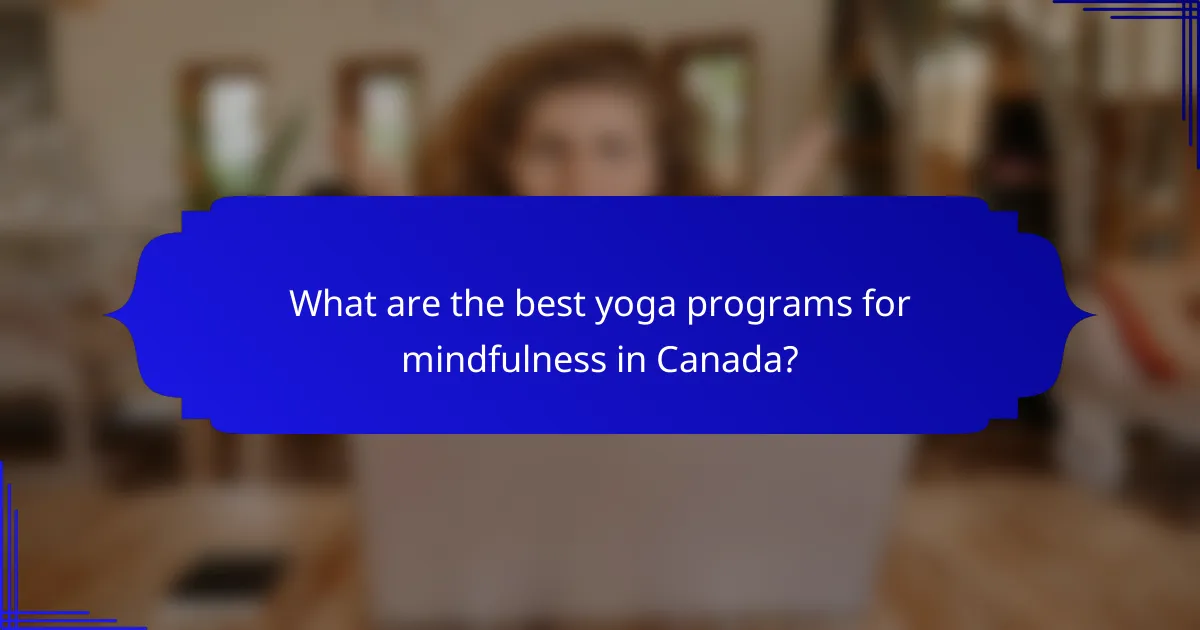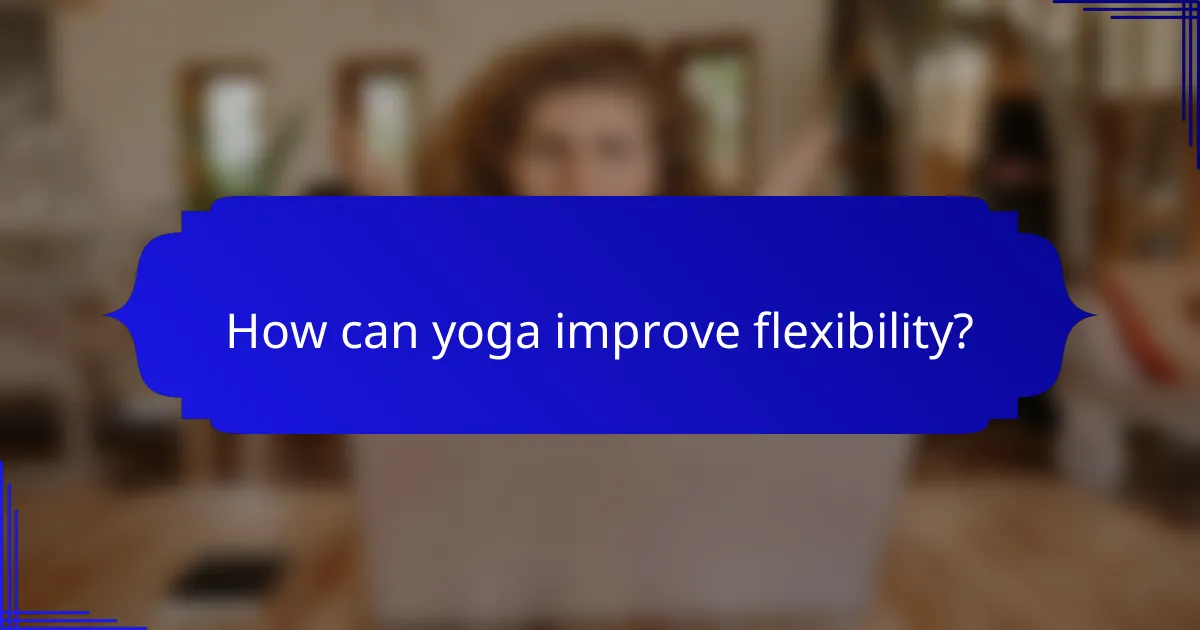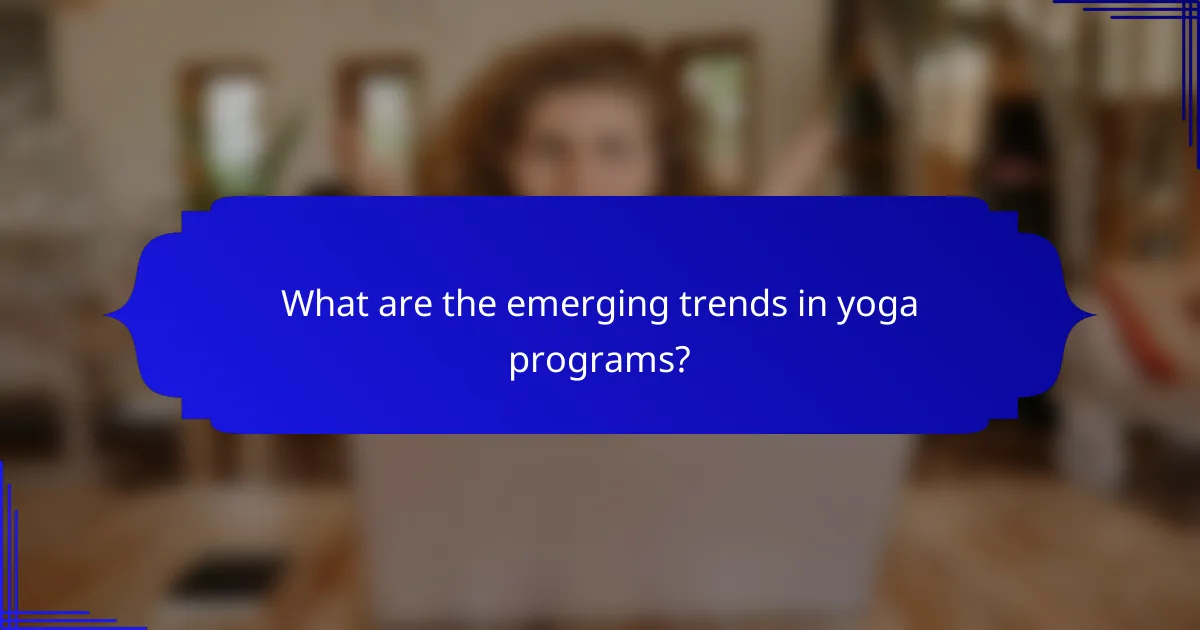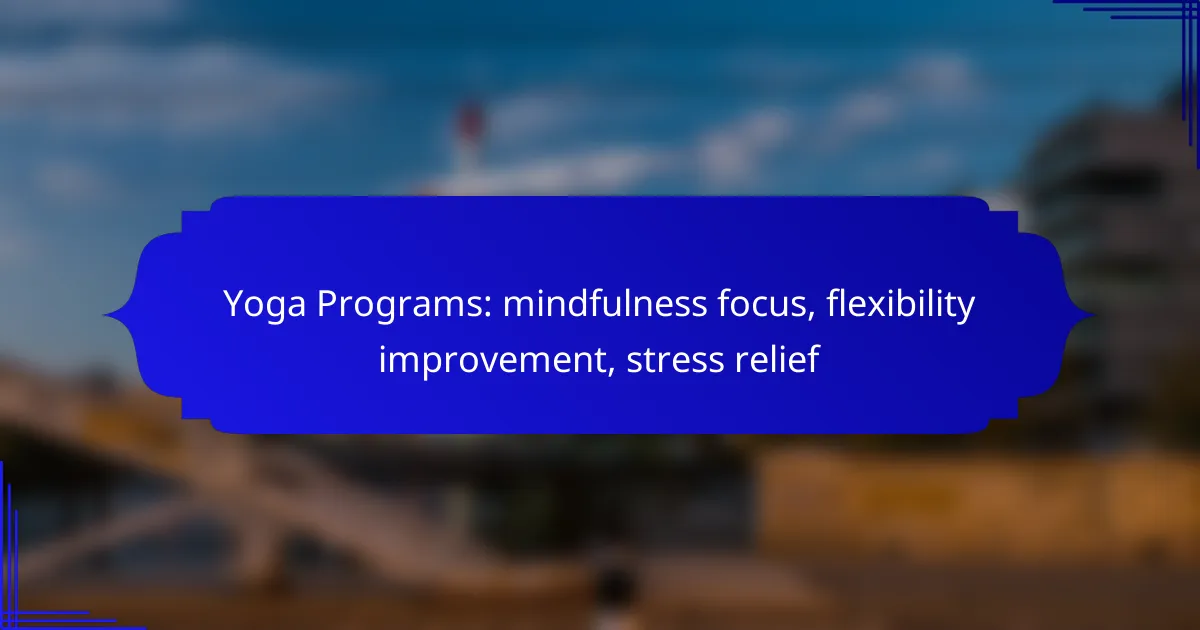Yoga programs that emphasize mindfulness, flexibility, and stress relief offer a holistic approach to well-being. By engaging in practices like Mindfulness-Based Stress Reduction and restorative yoga, participants can enhance mental clarity, improve flexibility, and effectively manage stress. These programs cater to various skill levels, making them accessible and beneficial for everyone seeking a deeper connection with themselves and a more balanced life.

What are the best yoga programs for mindfulness in Canada?
The best yoga programs for mindfulness in Canada focus on enhancing mental clarity, reducing stress, and fostering a deeper connection with oneself. Programs like Mindfulness-Based Stress Reduction (MBSR) and Yoga for the Mind by Yoga Alliance are popular choices that cater to various skill levels and preferences.
Mindfulness-Based Stress Reduction (MBSR)
Mindfulness-Based Stress Reduction (MBSR) is an evidence-based program designed to help individuals manage stress through mindfulness practices. Typically lasting eight weeks, MBSR combines meditation, body awareness, and yoga to cultivate a mindful approach to daily life.
Participants engage in weekly group sessions and daily home practices, which may include guided meditations and gentle yoga. This structured approach helps individuals develop skills to cope with stress, anxiety, and chronic pain, making it a valuable option for many Canadians.
Yoga for the Mind by Yoga Alliance
Yoga for the Mind, offered by Yoga Alliance, emphasizes the mental aspects of yoga practice. This program integrates mindfulness techniques with traditional yoga postures to enhance emotional well-being and mental clarity.
Classes often include breathwork, meditation, and reflective practices, allowing participants to explore their thoughts and feelings in a supportive environment. This program is suitable for all levels and can be found in various studios across Canada, making it accessible to a wide audience.
Hatha Yoga for Mindfulness
Hatha Yoga for Mindfulness focuses on the physical postures of yoga while integrating mindfulness principles. This approach encourages practitioners to be present in their bodies and cultivate awareness of their breath and movements.
Classes typically involve slower-paced sequences that allow for deeper exploration of each pose, fostering a meditative state. Many studios in Canada offer Hatha Yoga classes specifically designed for mindfulness, making it an excellent choice for those seeking to improve their flexibility and mental focus simultaneously.

How can yoga improve flexibility?
Yoga enhances flexibility by promoting the elongation of muscles and the release of tension through various poses and stretches. Regular practice can lead to increased range of motion and reduced stiffness, making everyday activities easier and more comfortable.
Vinyasa Flow Yoga
Vinyasa Flow Yoga emphasizes fluid movement and breath synchronization, making it an effective practice for improving flexibility. Each pose transitions smoothly into the next, allowing for dynamic stretching that targets multiple muscle groups.
To maximize flexibility gains, focus on maintaining proper alignment and breathing deeply during each transition. Practicing Vinyasa at least two to three times a week can yield noticeable improvements over time.
Ashtanga Yoga
Ashtanga Yoga follows a set sequence of poses, promoting strength and flexibility through a structured approach. This style is physically demanding, which can lead to significant improvements in flexibility as practitioners work through the series of postures.
Consider starting with a modified version of the sequence if you’re new to yoga. Consistent practice, ideally three to five times a week, will help you gradually deepen your stretches and enhance your overall flexibility.
Yin Yoga
Yin Yoga focuses on long-held, passive stretches that target deep connective tissues, making it particularly effective for increasing flexibility. Poses are typically held for several minutes, allowing for a profound release of tension and improved joint mobility.
Incorporate Yin Yoga into your routine once or twice a week to complement more active styles. Pay attention to your body’s signals and avoid pushing into pain, as the goal is to gently encourage flexibility over time.

What are effective yoga practices for stress relief?
Effective yoga practices for stress relief focus on calming the mind and relaxing the body. Techniques such as restorative yoga, gentle yoga, and yoga nidra can significantly reduce stress levels and promote overall well-being.
Restorative Yoga
Restorative yoga is a gentle form of yoga that uses props to support the body in restful poses. This practice encourages deep relaxation and helps alleviate tension, making it ideal for stress relief. Sessions typically last 60 to 90 minutes, allowing ample time for each pose.
In restorative yoga, poses are held for longer durations, often between 5 to 15 minutes, which allows the body to fully relax. Common poses include supported child’s pose and legs-up-the-wall, both of which promote a sense of calm and tranquility.
Gentle Yoga
Gentle yoga is designed for those who prefer a slower-paced practice that emphasizes relaxation and flexibility. This style incorporates basic poses and breathing techniques that help reduce stress while improving physical flexibility. Classes usually last around 45 to 75 minutes.
In gentle yoga, practitioners are encouraged to listen to their bodies and modify poses as needed. This approach fosters a supportive environment, making it accessible for beginners and those dealing with stress-related issues.
Yoga Nidra
Yoga nidra, or yogic sleep, is a guided meditation practice that promotes deep relaxation and stress relief. During a typical session, which lasts about 30 to 45 minutes, participants lie down comfortably while a teacher guides them through various stages of relaxation.
This practice helps to quiet the mind and can lead to a state of conscious awareness between waking and sleeping. Regular practice of yoga nidra can enhance emotional resilience and reduce anxiety, making it a powerful tool for stress management.

What should I consider when choosing a yoga program?
When selecting a yoga program, consider factors such as the instructor’s qualifications, class size, and the program’s duration and frequency. These elements significantly impact your experience and the effectiveness of the program in achieving your mindfulness, flexibility, and stress relief goals.
Instructor qualifications
Instructor qualifications are crucial for ensuring a safe and effective yoga experience. Look for instructors with recognized certifications, such as those from Yoga Alliance or similar organizations, which indicate a standard level of training. Additionally, consider their experience in teaching specific styles of yoga that align with your goals, such as Hatha for flexibility or Restorative for stress relief.
It can be beneficial to read reviews or testimonials from previous students to gauge the instructor’s teaching style and effectiveness. A good instructor should not only guide you through poses but also provide modifications and support tailored to your individual needs.
Class size and environment
The class size and environment can greatly influence your yoga practice. Smaller classes often allow for more personalized attention from the instructor, which can enhance your learning and safety. On the other hand, larger classes may create a more energetic atmosphere but might limit individual feedback.
Consider the studio’s ambiance as well; a calm, inviting environment can enhance your mindfulness and relaxation. Look for studios that prioritize cleanliness and have a peaceful setting, as these factors contribute to a more enjoyable experience.
Program duration and frequency
Program duration and frequency are key to establishing a consistent yoga practice. Many programs range from a few weeks to several months, with classes typically held once or twice a week. Assess your schedule and commitment level to choose a program that fits your lifestyle and allows for regular attendance.
For optimal benefits, aim for a frequency that challenges you but is also sustainable. If you’re new to yoga, starting with shorter sessions or fewer classes per week can help you build a solid foundation without overwhelming yourself.

How do local yoga studios in Canada compare?
Local yoga studios in Canada offer diverse programs focusing on mindfulness, flexibility, and stress relief, each with unique approaches and specialties. Understanding these differences can help you choose a studio that best fits your personal wellness goals.
Yoga Tree in Toronto
Yoga Tree in Toronto is known for its emphasis on community and holistic wellness. They offer a variety of classes that integrate mindfulness practices with physical postures, making it suitable for both beginners and experienced yogis.
The studio features specialized programs such as restorative yoga and meditation sessions aimed at stress relief. Consider attending their workshops, which often include guest instructors and focus on deepening your practice.
YYoga in Vancouver
YYoga in Vancouver provides a modern approach to yoga with a strong focus on flexibility and strength. Their classes range from gentle flow to more vigorous styles, catering to different skill levels and preferences.
They also offer unique programs like aerial yoga and hot yoga, which can enhance flexibility and provide a different experience. Membership options include unlimited access, allowing you to explore various classes throughout the month.
Downward Dog Yoga in Toronto
Downward Dog Yoga in Toronto is recognized for its skilled instructors and welcoming atmosphere. The studio focuses on alignment and mindfulness, making it an excellent choice for those looking to improve their practice while reducing stress.
They offer a range of classes, including yin yoga and vinyasa flow, which promote flexibility and relaxation. New students can take advantage of introductory offers to explore different classes and find what resonates best with them.

What are the emerging trends in yoga programs?
Emerging trends in yoga programs focus on mindfulness, flexibility improvement, and stress relief. These trends reflect a growing interest in holistic wellness and the integration of yoga into everyday life.
Mindfulness Focus
Yoga programs are increasingly emphasizing mindfulness, which involves being present and fully engaged in the moment. This approach can enhance the mental benefits of yoga, helping practitioners cultivate awareness and reduce anxiety.
Mindfulness in yoga often includes techniques such as breath awareness and meditation. Classes may incorporate guided meditations or specific breathing exercises to deepen the connection between mind and body.
Flexibility Improvement
Flexibility improvement remains a key goal in many yoga programs, appealing to both beginners and seasoned practitioners. Regular practice can lead to increased range of motion and reduced risk of injury.
Programs often include a variety of poses that target different muscle groups, with a focus on gradual progression. For instance, incorporating dynamic stretches and restorative poses can help enhance flexibility over time.
Stress Relief
Stress relief is a primary benefit of yoga, and many programs are designed specifically to address this need. Techniques such as deep breathing, gentle movements, and relaxation poses can significantly lower stress levels.
Classes aimed at stress relief may include restorative yoga or yin yoga, which focus on slow-paced poses held for longer durations. Practitioners are encouraged to listen to their bodies and prioritize relaxation throughout the practice.
